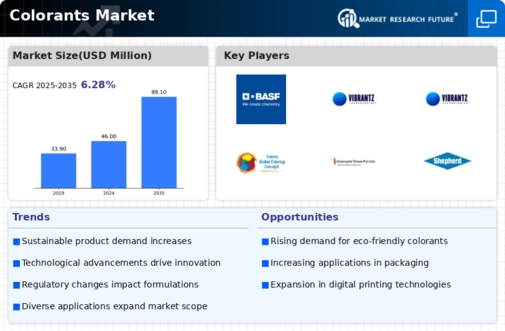Market Trends
Key Emerging Trends in the Colorants Market
The colorants market has witnessed significant trends in recent years, driven by various factors influencing consumer preferences, technological advancements, and regulatory changes. One prominent trend is the increasing demand for eco-friendly and sustainable colorants. With growing environmental concerns and stricter regulations regarding hazardous chemicals, consumers and industries alike are opting for colorants derived from natural sources or those with minimal environmental impact. This shift is evident across various sectors, including food and beverages, cosmetics, textiles, and plastics, where companies are embracing natural pigments, plant-based dyes, and biodegradable colorants to meet sustainability goals and cater to eco-conscious consumers.
Another notable trend in the colorants market is the emphasis on product innovation and customization. As competition intensifies, companies are striving to differentiate their offerings by developing unique color solutions tailored to specific customer requirements. This trend is particularly pronounced in industries such as automotive coatings, where manufacturers seek custom color formulations to enhance brand identity and product aesthetics. Additionally, advancements in colorant technologies, such as nanotechnology and microencapsulation, are enabling the development of innovative color solutions with superior performance characteristics, driving further market growth and expansion.
Moreover, the rapid pace of urbanization and industrialization across emerging economies is fueling the demand for colorants in various applications. As disposable incomes rise and consumer lifestyles evolve, there is a growing inclination towards aesthetically pleasing products, driving the adoption of vibrant colors in packaging, home décor, and personal care products. This trend is especially prominent in regions like Asia-Pacific and Latin America, where burgeoning middle-class populations are driving consumption patterns and influencing market dynamics.
Furthermore, the digital transformation of industries is reshaping the colorants market landscape, with the integration of digital color management systems and technologies revolutionizing color formulation processes. Digital tools such as spectrophotometers, colorimeters, and software solutions enable precise color matching, consistency, and reproducibility, thereby streamlining production workflows and reducing time-to-market. This trend is observed across diverse sectors, from printing and graphic arts to plastics manufacturing, where accuracy and consistency of colors are critical for product quality and brand integrity.
Additionally, the COVID-19 pandemic has had a profound impact on the colorants market, triggering shifts in consumer behavior and market dynamics. While the pandemic initially disrupted supply chains and manufacturing operations, leading to temporary slowdowns, it also accelerated certain trends such as the demand for antimicrobial coatings and hygiene-related products. As consumers prioritize health and cleanliness, there is a growing need for colorants infused with antimicrobial properties for applications in healthcare, packaging, and high-touch surfaces, driving market growth in this segment.










Leave a Comment